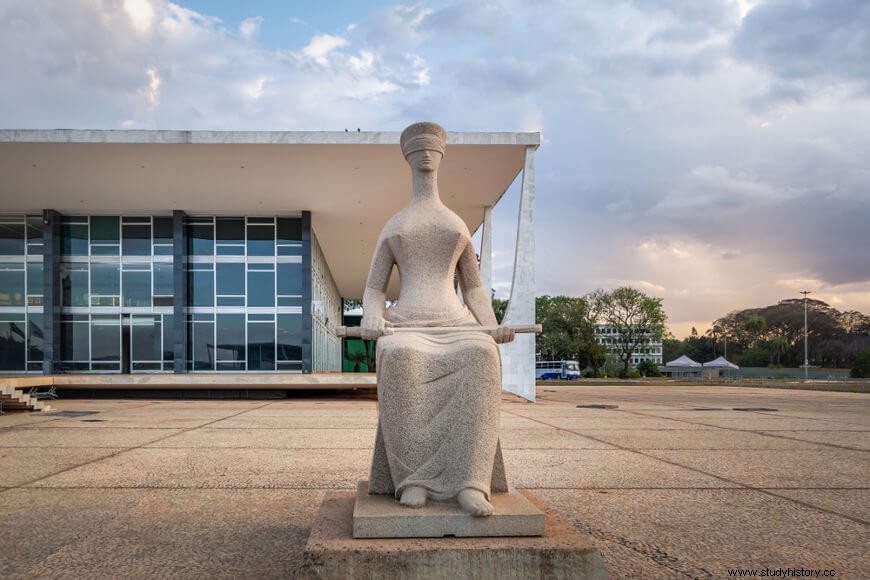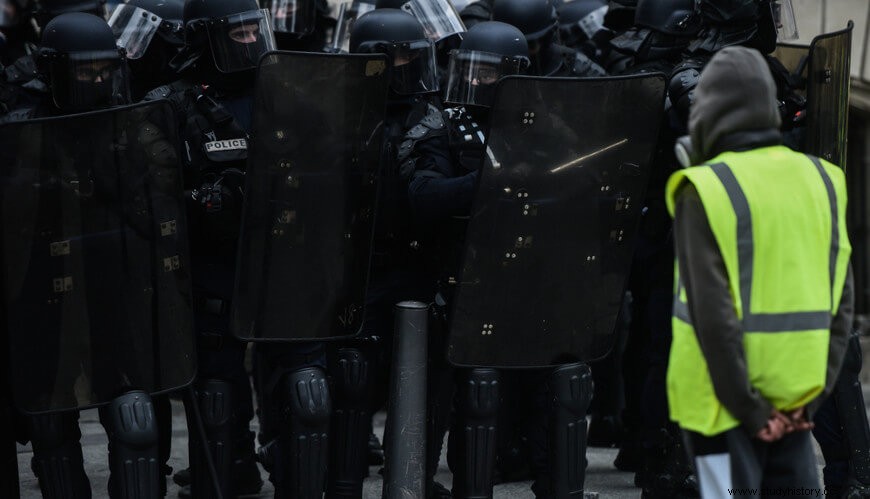
The democracy emerged in Ancient Greece , around 5th century BC . The meaning of the term, when translated from ancient Greek, is power (kratos ) of the people (demos ). At this time, the Athenians developed apolitical system based on direct participation of all those who were considered citizens of the polis in city decision-making. A citizen is one who takes part, who participates in city life. Athenian citizens met in large legislative assemblies, in the agora of Athens, to present proposed laws and vote directly on the proposals of other citizens.
The concept of democracy has changed in Modernity, expanding the capacity for participation citizen and it only took, once and for all, the form it has today from the 20th century onwards, with new models and democratic experiences and universal suffrage (the possibility of voting extended to all, without distinction).
Also read: History of Elections in Brazil
Types of Democracy
It is difficult to exhaust the meanings of the word democracy, as it is applied in many contexts and has different forms and stages of development . In the context of grand politics, responsible for the management of national states and related to governments, we can list three forms of democracy:
-
Democracy direct: this form of democracy is practically extinct in contemporary times, it is the one exercised in Athens, in Classical Greece. Citizens gathered in a public square (agora ) and they themselves presented their political proposals, which were chosen by popular vote. This model was possible thanks to the restriction of the concept of citizenship, which included only men, Athenians, children of Athenians and those over 21 years of age.
-
Democracy representative: a type of indirect democracy exercised through the popular election of leaders who will act in the Legislative and Executive branches, governing and legislating, theoretically, in favor of those who elected them. In other words, it is the most used system nowadays because it contains a logic of representativeness in which elected politicians act representing the mass of the population, which guarantees a better execution in the face of the breadth of the contemporary concept of citizenship.
-
Democracy participatory :considered a semi-direct system, participatory democracy is situated between representative democracy and direct democracy. Citizens, in addition to electing representatives, actively participate, through plebiscites and assemblies, in decision-making by the Executive and Legislative powers, giving their approval to decisions that are no longer taken only by the representatives of the aforementioned powers.
Also read: Populism:concept, characteristics, populist presidents
Examples of Democracy
Democracy can be exercised in various ways. Today, we have democratic regimes in presidential republican systems, in parliamentary republican systems (when the parliament, which heads the Legislative Power, is also the head of the Executive Power, electing a prime minister, who will act in submission to the Legislative Power) and even in monarchies , as is the case in the United Kingdom.
Most contemporary democratic systems are representative. However, it is important to point out that the practice of elections does not guarantee the democratic character of a political regime, since the isonomy and reliability of elections, in addition to freedom of expression and political association, fundamental marks of democracy, must be respected for a regime to be democratic, which is not always the case.
The participatory democracy , guaranteed by the Federal Constitution of 1988 in Brazil, is still not practiced here. However, some places, such as Switzerland and some states in the United States, use the semi-direct system, promoting elections of representatives and regular consultations with the population before important political decisions are made.
Modern Democracy
The Modernity experienced great political revolutions and the flowering of new ideals which aimed to end the Old Regime and caste privileges by promoting ideals of equality and freedom . In this context, France and United States were avant-garde in the defense of democracy, which would become a fundamental mark of contemporary Western politics.
Older democratic regimes have faced crises due to its wear and tear, which generates tiredness and popular dissatisfaction. On the other hand, contemporary democratic regimes, strongly inspired by the modern democratic ideal , also face crises in the face of the people's lack of habit of democratic experience.
The largest marks da democracy modernity were the establishment of the idea of a Democratic State of Rights, the constitutionalization and universality of citizenship, which was effectively achieved through universal suffrage.
The latter reached its apex with the feminist suffragette movements that took over Europe at the end of the century XIX and first half of the century XX, claiming the right of the female vote . The first democracy to allow women to vote was New Zealand, in 1893. In Brazil, this possibility only materialized after the 1930 Revolution, with the political reform of Getúlio Vargas, which aimed to curb the practice of halter voting. and expand national citizenship.
Democracy and Dictatorship

The popular struggle against authoritarianism is fundamental for the maintenance of democracy.**
Dictatorship is, in essence, opposite to democracy . If in a democratic regime there is popular political deliberation, in a dictatorship there is the imposition of practices and laws, against the will of the people. From this concept, confusion can be generated, as many dictatorships maintain local electoral systems, for heads of mayors and governments, as happened during the Military Dictatorship in Brazil and during the dictatorship of Getúlio Vargas. There can also be fraudulent and partial elections that keep dictator heads of state in power for many years.
In general, dictatorships nullify democracy by closing Parliament or government intervention in the Legislative Branch. There is also the temporary suspension of the Constitution, generating what is called a state of exception.
To be considered effectively democratic, a country must have, in addition to broad citizen participation:
-
freedom of speech;
-
press freedom;
-
freedom of political association;
-
unrestricted access to information;
-
transparency and political fairness in resource management;
-
reputable and transparent elections, which respect the rules established by international organizations.
Contemporary French philosopher Jacques Rancière wrote a book entitled Hate of Democracy , in which he is dedicated to studying the contemporary phenomenon that causes citizens of old democracies to reject democratic thinking and, in a wave conservative, ask for the dictatorship.
According to the thinker, democracy is the regime of opposition and dissent. Disagreement should be seen as common, but the way out is the agreement of different thoughts that results, as in a dialectical process, in a moderate action. Amid the non-acceptance of different thinking, people call for the end of democracy and the establishment of the imposition of their own ideas as if they were the only correct ones.
Also read :Totalitarianism:what it is, totalitarian regimes, characteristics
Democracy in Brazil
Since the establishment of republicanism , Brazil has a complicated relationship with democracy. Our democratic history begins with a republican coup against the Empire of Dom Pedro II. Between 1889 and 1894, Deodoro da Fonseca and Floriano Peixoto ruled without popular elections. Until 1930, the policy of oligarchies, formed by groups of rich coffee and cattle producers, those from São Paulo and those from Minas Gerais, dominated the National Executive Power.
The coup of 1930 established a new policy, but kept Getúlio Vargas in power, who remained and governed in a dictatorial manner closing Congress and not holding elections presidential. In 1945, the republic was reopened, and popular participation in the presidential choice went back until 1964, when a civil-military coup took place that deposed President João Goulart.
The military remained in power until 1985, with indirect presidential elections, moments of suspension of constitutional political and civil rights (establishing a state of exception) and even closure of the National Congress .
After the end of the Military Dictatorship, José Sarney was elected president of the country by the National Congress. A long movement in favor of direct elections for president, called Direct now! , escalated until, with the Constituent Reform of 1988, Brazilian citizens regained the right to vote directly for the head of the National Executive Power.
In the midst of ups and downs, Brazilian democracy seems to waver, causing an unstable and uncomfortable situation for citizens.
*Image Credits:Diego Grandi / Shutterstock
**Image Credits:pcruciatti / Shutterstock
